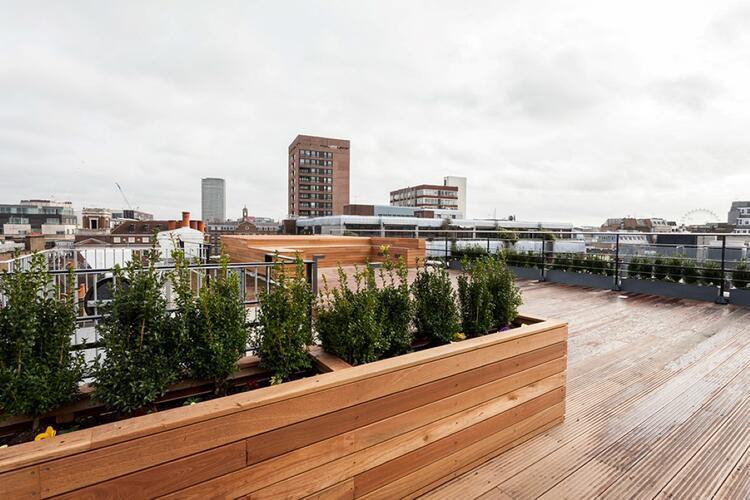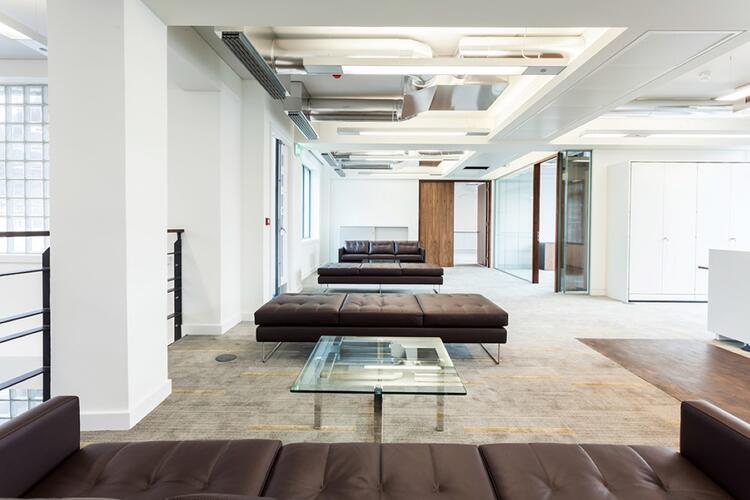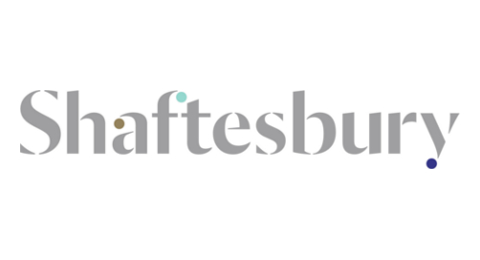Shaftesbury’s Sustainable Retrofit at 22 Ganton Street
11 November 2015Shaftesbury’s Sustainable Retrofit at 22 Ganton Street
11 November 2015Shaftesbury completed the refurbishment of 22 Ganton Street in London’s West End in 2014, delivering 11,670 sq ft of Grade A office space. The project exemplifies the company’s proactive approach to asset management and commitment to the long-term sustainability of its buildings. By retaining 99% of the building’s structure and 80% of its façade, Shaftesbury significantly reduced the amount of new materials required and cut construction waste, minimising environmental impacts and generating cost savings. In addition, upgrades to insulation, heating and lighting improved the building’s energy efficiency and operational costs. A species diverse green roof and wall are also providing an attractive area for occupiers and enhancing biodiversity in central London.
Key Facts
- BREEAM Very Good in a 1920s building
- Energy Performance Certificate (EPC) B
- Healthy and contemporary environment
- Enhanced occupier appeal
- Increased rental value
- Extending the building’s useful life
Situation
Shaftesbury is a property investment company, which focuses exclusively on the West End of London. 22 Ganton Street is six-storey building, just off London’s iconic Carnaby Street. Originally built in around 1920, it has been owned by Shaftesbury since the mid-1990s and was previously refurbished in 1999. It is a multi-occupied building, which now includes Shaftesbury’s new London Head Office.
The project team comprised architect MR Partnership, project management firm Single Point Project Management, main contractor Blenheim House Construction, and mechanical and electrical consultants Watkins Payne Partnership. Together, they transformed the existing building, remodelling the reception area, refurbishing lobbies, stairs and toilets throughout, upgrading windows and cladding, creating a duplex office space on the two top floors and introducing new terraces, including a green roof, green wall, seating and decked areas.
Actions
Energy
- Mechanical ventilation heat recovery, requiring around 50% less energy than heating outside air
- Low energy lighting including LED lamp sources, 50% more efficient than required by Building Regulations
- Lighting control system with automatic daylight dimming and occupancy detection (motion sensors), 25% more efficient than previous manual switching
- A+ rated insulation materials cutting heat loss, including green roof, cavity insulation, plasterboard, duct wrap and pipe lagging
- Energy sub-metering for lighting, small power, lifts, fresh air units, air conditioning units and all occupied areas.
Water
- Water saving fittings, including low flow taps at 5 litres per minute and dual flush toilets at 6 / 4 litres
- Valves linked to motion sensors in toilet entry areas, shutting off the water supply when areas are unoccupied
- Water sub-metering with pulsed output installed where the water demand exceeds 10% of total consumption.
Materials
- 99% of the existing building structure and 80% of the façade retained
- 99% of new insulation certified responsibly sourced
- Most existing timber retained, including all the roof structure, 95% of bannisters and 90% of skirting boards
- 86% of new timber purchased from certified sustainable sources
- Recycled aluminium and steel specified as part of the design.
Ecology
- Extensive green roof, comprising a vegetation blanket featuring sedums selected to flourish in the UK climate
- Green wall with bird boxes, bird feeders and a range of plant species, such as Catlin's Giant, winner of the Royal Horticultural Society's Award of Garden Merit, the lesser periwinkle and great wood-rush
- Wildflower areas on the green roof, increasing floral species and providing foraging resource for widespread invertebrate and bird species
- Patches of bare ground and stone on the green roof, benefiting species such as butterflies, bees and wasps
- Insect hotels, benefiting ladybirds and other bugs.
Health and wellbeing
- All workstations within seven metres of a window with a view out
- All office lighting carefully zoned, so workers can control light levels for zones of up to four workplaces, and workstations next to windows separately zoned and controlled
- Heating and cooling system allowing occupiers to control zoned areas in all occupied spaces
- Lighting levels in line with the CIBSE Code for Lighting, with consideration for areas where computer screens are regularly used, e.g. avoiding screen reflections
- Thermal comfort levels in line with CIBSE Guide A – Environmental Design recommendations
- All fluorescent lamps fitted with high frequency ballasts to reduce the risk of issues related to flickering lights.
Management
- All mechanical and electrical commissioning in line with good practice guidelines, including BSRIA and CIBSE
- Considerate Constructors Scheme score of 35/50, ahead of the 32/50 target, with all areas rated Very Good, covering care about appearance, community, environment, safety and workforce
- Building User Guide for areas including environmental strategy, energy, water, transport, materials, waste and refits.
Financials
- £4 million total project cost
- 8% return on total investment
- Enhanced rental income, with space leased quickly at good market rents
- Energy cost savings for occupiers.
Shaftesbury did not specifically analyse project expenditure in terms of potential additional costs for efficiency measures. These are part of business as usual for the firm on refurbishments, with new technologies and products delivering efficiency improvements, and Shaftesbury aware that the occupiers it wants to attract expect modern office space to be both comfortable and efficient.
Benefits
Enhanced occupier appeal, increasing rental value and lettability, as well as attracting Shaftesbury to relocate to the building:
- Healthier, more contemporary indoor environment for workers, with new lighting system that is both attractive and efficient
- Outdoor terraces with seating, planting, green wall and views across London, as well as ecological value
- Exposed services enhanced lettability by giving a sought-after look, whilst also reducing materials use.
Supporting occupiers’ sustainability goals, including Shaftesbury:
- Enhanced ecological value, with the creation of 140 sq ft of species diverse green space, described in the BREEAM report as a ‘new, locally-relevant, ecologically valuable habitat’
- Improved operational energy efficiency, cutting CO2 emissions
- 8% less water consumption per person than the BREEAM requirement, at 5 m³ per person per year
- Stronger sustainability credentials, achieving BREEAM Very Good and an EPC B rating, previously unrated.
Additional benefits for Shaftesbury:
- Reduced construction costs and environmental impacts, through the retention of 99% of the building’s structure and 80% of its façade, as well as the re-use of a significant proportion of timber in the building
- Reduced exposure to the Government’s Minimum Energy Efficiency Standards, which come into force in 2018.
Challenges and Achievements
BREEAM
How to achieve BREEAM Very Good?
A BREEAM professional was an integral member of the design team, from the initial design brief (RIBA Stage B) until the completion of technical design (RIBA Stage E). An experienced, qualified ecologist also carried out a habitat survey before works started. Both appointments contributed to the project achieving a BREEAM Very Good rating, with 80% scores for ecology, management, transport and land use.
LOGISTICS
How to minimise local disruption?
Shaftesbury introduced a range of initiatives to minimise disruption for local businesses and residents. This not only supported good community relations, it was also important for customer satisfaction, as Shaftesbury owns the surrounding buildings on Ganton Street. Initiatives included members of the team organising vehicle deliveries in the street for the site and for adjoining premises, so that both construction and restaurant deliveries on the fairly narrow street progressed as smoothly as possible during the busy 7am to 11am permitted access period. The team also liaised closely with local businesses, for instance scheduling noisy works not only within the core hours agreed with Westminster City Council but also for times that minimised any impact on local trading.
REFURBISHMENT
How to improve thermal insulation in a 1920s building?
Much of Shaftesbury’s portfolio comprises older buildings and so the company is experienced at refurbishing older buildings to meet modern standards for occupier appeal and sustainability. 22 Ganton Street is not a listed building. The main challenge in improving the thermal insulation of the building fabric related to access arrangements in bringing large elements to site, such as new double glazed windows and new wall and roof insulation. A first floor gantry was created to allow deliveries to be loaded here and then distributed around the site.
Find out more
Rob Kirk
Portfolio Executive
Shaftesbury
www.shaftesbury.co.uk
*Please note that the information on this page was supplied by the BBP Member and the BBP assumes no responsibility or liability for any errors or omissions in the content



